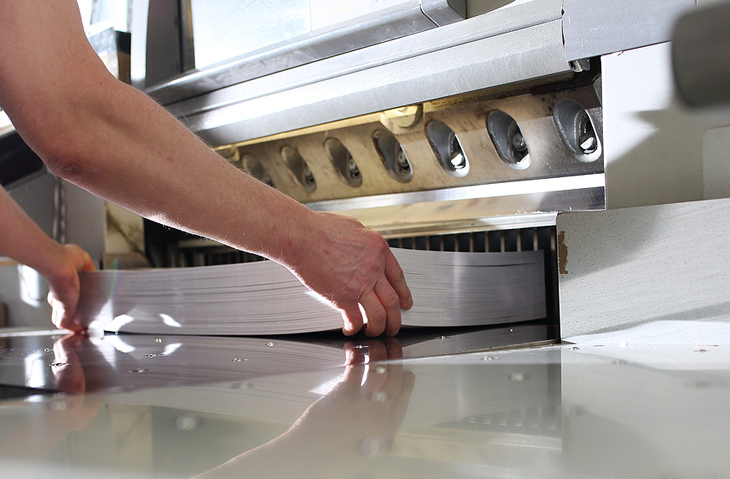
The process of combining printed sheets into finished products such as books, magazines, catalogs, folders, and directories is known as “binding.” When publications or advertising supplements have been printed, they must then be folded, glued, stitched, stapled, trimmed, or otherwise turned into the finished product that will be seen by the public. Bindery workers set up, operate, and maintain the machines that perform these various tasks, while bookbinders perform highly skilled hand finishing operations.
Job duties depend on the material being bound. Some types of binding and finishing jobs consist of only one step. Preparing leaflets or newspaper inserts, for example, requires only folding and trimming. Binding books and magazines, on the other hand, requires a number of steps. Bindery workers first assemble the books and magazines from large, flat, printed sheets of paper. They then operate machines that first fold printed sheets into “signatures,” which are groups of pages arranged sequentially. They then assemble the signatures in sequence and join them by means of a saddle-stitch process or perfect binding (where no stitches are used). In firms that do “edition binding,” workers bind books produced in large numbers, or “runs.”
Bookbinders also do repair work on rare books, such as sewing, stitching, or gluing the assembled printed sheets. They also shape book bodies with presses and trimming machines and reinforce them with glued fabric strips. Covers are created separately and glued, pasted, or stitched onto the book bodies. The books then undergo a variety of finishing operations, often including wrapping in paper jackets. In establishments that print new books, this work is done mechanically.
A small number of bookbinders work in hand binderies. These highly skilled workers design original or special bindings for limited editions, or restore and rebind rare books. Some binders repair books and provide other specialized binding services to libraries.
Bookbinders and bindery workers in small shops may perform many binding tasks, while those in large shops tend to specialize. Tasks may include performing perfect binding or operating laminating machinery. Others specialize as folder operators or cutter operators, and may perform adjustments and minor repairs to equipment as needed.
Work Environment
Binderies often are noisy and jobs can be strenuous, requiring considerable lifting, standing, and carrying. Binding often resembles an assembly line on which workers perform repetitive tasks. The jobs also may require stooping, kneeling, and crouching. Equipment and protective clothing that help minimize injuries is available; however, minor injuries occur frequently in the occupation. Bookbinders and bindery workers normally work 40 hours per week, although weekend and holiday hours may be necessary to meet production schedules. Some bindery workers may work on shifts for larger printers that operate around the clock. Part-time and on-call schedules are common to meet fluctuating demand or impending deadlines.
Education & Training Required
High school students interested in bindery careers should take shop courses or attend a vocational-technical high school. Occupational skill centers also provide an introduction to bindery work and bookbinding. For entry-level positions, most employers look for high school graduates or those with associate degrees.
Training in graphic communications also can be an asset. Vocational-technical institutes offer postsecondary programs in the graphic arts, as do some skill-updating or retraining programs and community colleges. Other programs are made available by unions to their members. Four-year colleges also offer programs related to printing and publishing, but their emphasis is on preparing people for careers as graphic artists, educators, or managers in the graphic arts field.
While postsecondary education is available, most bookbinders and bindery workers learn the craft through on-the-job training. Inexperienced workers may start out as helpers and perform simpler tasks, such as moving paper from cutting machines to folding machines or catching stock as it comes off machines. They learn basic binding skills, including the characteristics of paper and how to cut large sheets of paper into different sizes with the least amount of waste. Usually, it takes one to three months to learn to operate simpler machines but it can take up to one year to become completely familiar with more complex equipment, such as computerized binding machines. As workers gain experience, they learn to operate more types of equipment. To keep pace with changing technology, retraining is increasingly important for bindery workers.
Formal apprenticeships are not as common as they used to be, but still are offered by some employers. Apprenticeships allow beginners to acquire skills by working alongside skilled workers while also taking classes. The more structured apprenticeship programs enable workers to acquire the high levels of specialization and skill needed for some bindery and bookbinding jobs.
Other Skills Required
Bindery work requires careful attention to detail. Accuracy, patience, neatness, and good eyesight are all important. Mechanical aptitude is necessary to operate automated equipment, and workers with computer skills will increasingly be in demand. Manual dexterity is needed in order to count, insert, and fold. In addition, creativity and artistic ability are necessary for hand bookbinding.
How to Advance
With experience, binders can expect increased salaries and more responsibility. Completion of a formal certification program can further advancement opportunities. Without additional training, advancement opportunities outside of bindery work are limited. In large binderies, experienced bookbinders or bindery workers may advance to supervisory positions.
Earnings
The middle 50 percent earned between $15.34 and $24.46 an hour. The lowest 10 percent earned less than $13.35, and the highest 10 percent earned more than $32.68.







